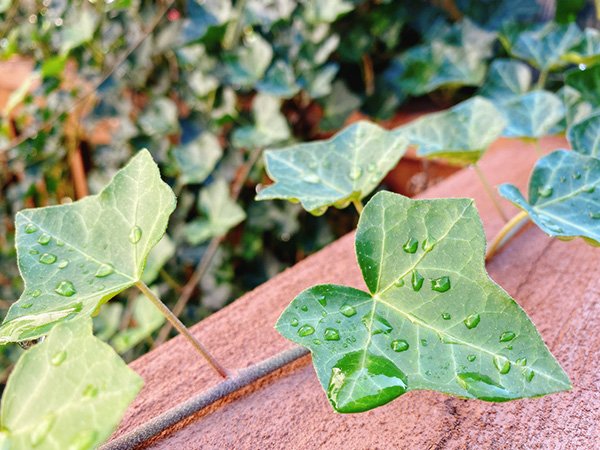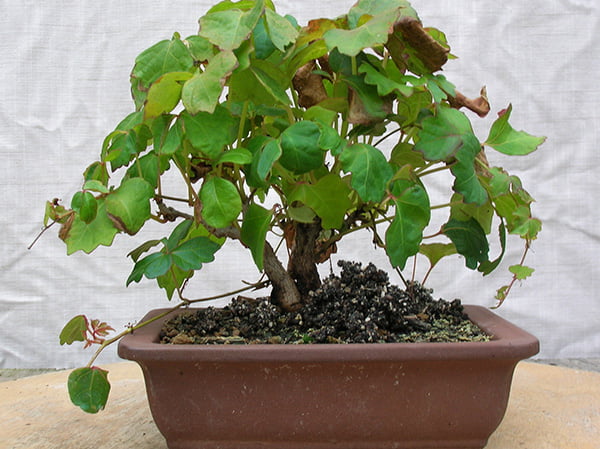Boston Ivy, also known by its scientific name Parthenocissus tricuspidata, is a truly remarkable plant that can transform any space into a stunning natural wonderland. With its striking green leaves that turn into a vibrant red hue in the fall, this climbing vine is a favorite among gardeners and nature enthusiasts alike.
Boston Ivy is a perfect choice to add some eye-catching beauty to your home or create a picturesque landscape in your backyard. This fast-growing vine can thrive in soil conditions that would pose problems to other growing plants, and you'll be rewarded with dense green foliage! Below, we'll list everything you need to know to plant, grow, and enjoy Boston ivy.
Botanical Name
Common Name
Plant Type
Mature Size
Sun Requirement
Soil Type
Hardiness Zone
Pet Friendly
Parthenocissus tricuspidata
Boston ivy, grape ivy, and Japanese ivy
Perennial
50 ft. long, 30 ft. wide
Full, partial
Loamy, moist
4–8 (USDA)
No
What Is Boston Ivy?
Boston ivy (Parthenocissus tricuspidata) isn't technically an ivy but does resemble poison ivy, and neither does it originate from Boston! It's actually more closely related to the grape family than true ivy, and it was brought to Massachusetts from Japan.
Boston ivy is technically an invasive plant in North America, but it grows in conditions that are not typically hospitable for native species, so there's little cause for concern.
Boston ivy clings to walls and other vertical surfaces, quickly growing to a full 60 feet in length! It is frequently confused with Virginia creeper, but the leaves are much different. The dark green leaves of Boston ivy are three-lobed, glossy, and consist of a single leaf. As the temperatures turn chilly, enjoy their vibrant red fall color!
Boston Ivy will provide spring and early summer flowers in greenish-white colors. The flowers are small and result in small berries - which the birds enjoy but are otherwise not particularly noticeable.
This rapid-growth deciduous vine works well as both a climbing plant and as ground cover. Like other members of the Vitaceae family, the vines have tendrils that grow directly opposite each leaf, wrapping around a trellis or clinging to cracks in a stone wall.
Fun fact: It was planted alongside many college and university buildings in the northwest USA, covering the brick exteriors thickly and giving these institutions the name "Ivy League"!
There are many different cultivars of this species of plant. Here are some to keep an eye out for:
"Fenway Park" - Named for the Boston baseball stadium with ivy-covered outfield walls, this Fenway Park specimen has a brilliant yellow-green color that brightens up a space.
"Ginza Lights" - This rare cultivar has white speckles across the dark green leaves, as well as smaller leaves in general than the standard Boston ivy.
"Green Showers" - Ginza Lights might have the smallest leaves, but Green Showers is on the other side of the spectrum! Each leaf of this variety can reach 10 inches in width!
Boston Ivy Care Requirements
Light
Much of the vigorous growth habit of Boston ivy depends on how much sunlight it receives! Full sun exposure is the goal, resulting in dense foliage and a blaze of red in autumn. Partial shade locations are also suitable, although the vines will grow slower. And while Boston ivy will still grow in full shade conditions, the vines will grow slowly, the leaves will be sparse, and the autumn color will be lackluster.
Water
Once you get your Boston ivy plant established, you won't need to worry much about watering it. Mature plants are exceptionally drought-tolerant, although they will benefit from the garden hose during summertime dry spells.

Source: Flickr
Temperature
Boston ivy grows best in USDA Hardiness Zones 4 through 8, and it doesn't handle overly long and cold winters or hot temperatures (both arid and humid). However, Boston ivy will grow well in almost all of the contiguous United States.
Soil
As you might expect from a plant that is often found growing up walls, Boston ivy doesn't have picky soil requirements. It can handle the dry, rocky, and often shallow soil conditions found near the foundations of buildings. However, the soil must have good drainage. A well-drained soil with a pH range between 5.0 and 7.5 is perfect for a Boston ivy plant.
Fertilization
An established Parthenocissus tricuspidata won't require fertilization, but it gives a helpful boost at planting time and during the first growing season - and it doesn't harm anything to fertilize once a year afterward! Boston ivy vines respond well to applying a balanced granular fertilizer in early spring.
Pruning
This low-maintenance vine does require some maintenance when it comes to pruning - particularly if it is growing up a wall. Boston ivy will quickly take over windows, gutters, shutters, and outdoor wiring. It's amazing the damage a climbing plant can do when left unchecked! However, there's a right way and a wrong way to go about pruning Boston ivy. And the best time to prune is late winter to control growth.
DO make your cuts right above a leaf node to prevent infection.
DON'T make your cuts and then pull the vines away. The disks found at the end of the tendrils will be left clinging to the walls, and they are difficult to remove! Instead, make your cuts and then wait for the vines to die off before pulling them down.
DO prune in the winter when the leaves have dropped. Pruning in the spring will cause the vine to grow back even more quickly and densely.
DON'T remove more than a third of the total plant in one go.
Propagation
Boston ivy can be grown from seeds or from cuttings. Whichever route you go, when it comes to planting your propagate ivy in the ground, space each plant 18 to 24 inches apart and at least a foot away from the wall.
Propagating From Seed
You'll plant your Boston ivy seeds in late spring when all threat of frost has passed. Loosen the top 6 inches of soil in your planting area. If the soil looks a bit "dead," work in some compost. Boston ivy will be fine once it gets established, but it needs decent nutrients while putting those roots down. Plant the seeds 1/2 inch deep, and keep the soil moist until the seedlings germinate and get settled.
Propagating From Cuttings
Use clean shears to cut the vine length from an existing Boston ivy plant with at least five nodes along its length. Pull off all of the leaves and tendrils except for the last two or three pairs at the tip. Dip the cut end in rooting hormone powder, then plant your cutting in a pot filled with an equal mix of perlite and peat moss. Place the pot in bright but indirect sunlight, and make sure to maintain moist soil! Once you see some new growth on your cutting, you can move your rooted cuttings into their permanent home.

Source: Flickr
Common Problems When Growing Boston Ivy
Many pests or diseases don't seriously threaten Boston ivy, but there are a few you should keep an eye out for.
Common Pests
Look for black vine weevils, eight-spotted forester moth caterpillars, and leaf hoppers in the summer. All of these insects will eat at your plant's leaves, and the weevil grubs will cause significant harm to the roots.
You can apply pathogenic insect nematodes to the soil to take care of the weevil grubs. The adult weevils, leafhoppers, and caterpillars should be removed using a direct spray of the garden hose and treatment of neem oil or insecticide.
Common Diseases
Boston ivy sometimes struggles with leaf spots and with powdery mildew, and fungi cause both. If you notice irregular dark spots, prune away infested leaves to keep the fungus from spreading and provide extra fertilizer.
Powdery mildew is known by gray or greenish-white patches on the leaves and is caused by lots of moisture during hot weather. Remove infected leaves to help control the spread, and do your best to increase airflow around the plant.
Invasive Growth
Boston Ivy can grow rapidly and become invasive if not kept in check. It's important to prune it regularly to prevent it from taking over other plants or structures in your garden.
Winter Damage
Boston Ivy is hardy in zones 4-8, but extremely cold temperatures can damage the plant. In areas with harsh winters, it's important to protect the plant from frost and provide adequate insulation.
Is Boston Ivy Pet Friendly?
Yes, Boston ivy is safe to grow around pets.
